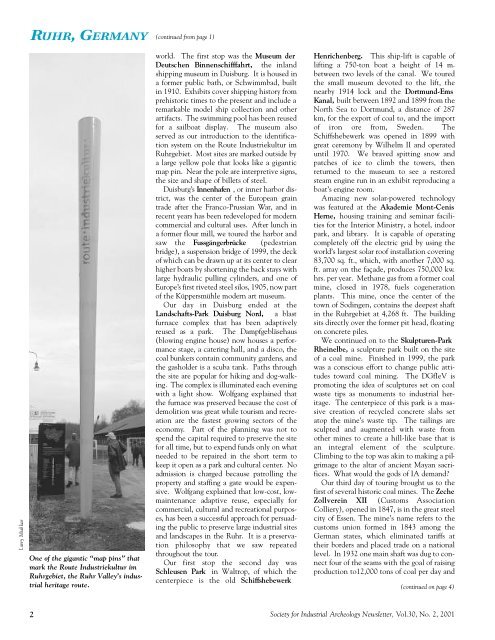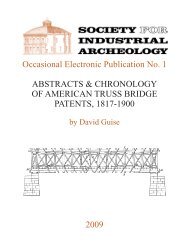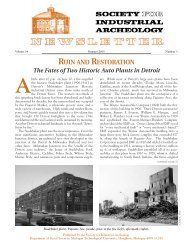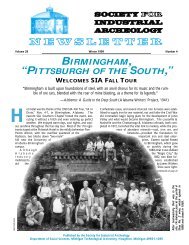RUHR, GERMANY - Society for Industrial Archeology
RUHR, GERMANY - Society for Industrial Archeology
RUHR, GERMANY - Society for Industrial Archeology
You also want an ePaper? Increase the reach of your titles
YUMPU automatically turns print PDFs into web optimized ePapers that Google loves.
<strong>RUHR</strong>, <strong>GERMANY</strong> (continued from page 1)<br />
One of the gigantic “map pins” that<br />
mark the Route Industriekultur im<br />
Ruhrgebiet, the Ruhr Valley’s industrial<br />
heritage route.<br />
world. The first stop was the Museum der<br />
Deutschen Binnenschifffahrt, the inland<br />
shipping museum in Duisburg. It is housed in<br />
a <strong>for</strong>mer public bath, or Schwimmbad, built<br />
in 1910. Exhibits cover shipping history from<br />
prehistoric times to the present and include a<br />
remarkable model ship collection and other<br />
artifacts. The swimming pool has been reused<br />
<strong>for</strong> a sailboat display. The museum also<br />
served as our introduction to the identification<br />
system on the Route Industriekultur im<br />
Ruhrgebiet. Most sites are marked outside by<br />
a large yellow pole that looks like a gigantic<br />
map pin. Near the pole are interpretive signs,<br />
the size and shape of billets of steel.<br />
D u i s b u r g ’s I n n e n h a f e n, or inner harbor district,<br />
was the center of the European grain<br />
trade after the Franco-Prussian Wa r, and in<br />
recent years has been redeveloped <strong>for</strong> mod e r n<br />
commercial and cultural uses. After lunch in<br />
a <strong>for</strong>mer flour mill, we toured the harbor and<br />
saw the F u s s g ä n g e r b r ü c k e ( p e d e s t r i a n<br />
bridge), a suspension bridge of 1999, the deck<br />
of which can be drawn up at its center to clear<br />
higher boats by shortening the back stays with<br />
large hydraulic pulling cylinders, and one of<br />
E u r o p e ’s first riveted steel silos, 1905, now part<br />
of the Küppersmühle modern art museum.<br />
Our day in Duisburg ended at the<br />
Landschafts-Park Duisburg Nord, a blast<br />
furnace complex that has been adaptively<br />
reused as a park. The Dampfgebläsehaus<br />
(blowing engine house) now houses a per<strong>for</strong>mance<br />
stage, a catering hall, and a disco, the<br />
coal bunkers contain community gardens, and<br />
the gasholder is a scuba tank. Paths through<br />
the site are popular <strong>for</strong> hiking and dog-walking.<br />
The complex is illuminated each evening<br />
with a light show. Wolfgang explained that<br />
the furnace was preserved because the cost of<br />
demolition was great while tourism and recreation<br />
are the fastest growing sectors of the<br />
e c o n o m y. Part of the planning was not to<br />
spend the capital required to preserve the site<br />
<strong>for</strong> all time, but to expend funds only on what<br />
needed to be repaired in the short term to<br />
keep it open as a park and cultural center. No<br />
admission is charged because patrolling the<br />
property and staffing a gate would be expensive.<br />
Wolfgang explained that low-cost, lowmaintenance<br />
adaptive reuse, especially <strong>for</strong><br />
commercial, cultural and recreational purposes,<br />
has been a successful approach <strong>for</strong> persuading<br />
the public to preserve large industrial sites<br />
and landscapes in the Ruhr. It is a preservation<br />
philosophy that we saw repeated<br />
throughout the tour.<br />
Our first stop the second day was<br />
Schleusen Park in Waltrop, of which the<br />
centerpiece is the old S c h i f f s h e b e w e r k<br />
Henrichenberg. This ship-lift is capable of<br />
lifting a 750-ton boat a height of 14 m.<br />
between two levels of the canal. We toured<br />
the small museum devoted to the lift, the<br />
nearby 1914 lock and the Dortmund-Ems<br />
Kanal, built between 1892 and 1899 from the<br />
North Sea to Dortmund, a distance of 287<br />
km, <strong>for</strong> the export of coal to, and the import<br />
of iron ore from, Sweden. The<br />
Schiffshebewerk was opened in 1899 with<br />
great ceremony by Wilhelm II and operated<br />
until 1970. We braved spitting snow and<br />
patches of ice to climb the towers, then<br />
returned to the museum to see a restored<br />
steam engine run in an exhibit reproducing a<br />
boat’s engine room.<br />
Amazing new solar-powered technology<br />
was featured at the Akademie Mont-Cenis<br />
Herne, housing training and seminar facilities<br />
<strong>for</strong> the Interior Ministry, a hotel, indoor<br />
park, and library. It is capable of operating<br />
completely off the electric grid by using the<br />
world’s largest solar roof installation covering<br />
83,700 sq. ft., which, with another 7,000 sq.<br />
ft. array on the façade, produces 750,000 kw.<br />
hrs. per year. Methane gas from a <strong>for</strong>mer coal<br />
mine, closed in 1978, fuels cogeneration<br />
plants. This mine, once the center of the<br />
town of Sodingen, contains the deepest shaft<br />
in the Ruhrgebiet at 4,268 ft. The building<br />
sits directly over the <strong>for</strong>mer pit head, floating<br />
on concrete piles.<br />
We continued on to the Skulpturen-Park<br />
Rheinelbe, a sculpture park built on the site<br />
of a coal mine. Finished in 1999, the park<br />
was a conscious ef<strong>for</strong>t to change public attitudes<br />
toward coal mining. The DGfIeV is<br />
promoting the idea of sculptures set on coal<br />
waste tips as monuments to industrial heritage.<br />
The centerpiece of this park is a massive<br />
creation of recycled concrete slabs set<br />
atop the mine’s waste tip. The tailings are<br />
sculpted and augmented with waste from<br />
other mines to create a hill-like base that is<br />
an integral element of the sculpture.<br />
Climbing to the top was akin to making a pilgrimage<br />
to the altar of ancient Mayan sacrifices.<br />
What would the gods of IA demand?<br />
Our third day of touring brought us to the<br />
first of several historic coal mines. The Zeche<br />
Zollverein XII (Customs Association<br />
Colliery), opened in 1847, is in the great steel<br />
city of Essen. The mine’s name refers to the<br />
customs union <strong>for</strong>med in 1843 among the<br />
German states, which eliminated tariffs at<br />
their borders and placed trade on a national<br />
level. In 1932 one main shaft was dug to connect<br />
four of the seams with the goal of raising<br />
production to12,000 tons of coal per day and<br />
(continued on page 4)<br />
2 <strong>Society</strong> <strong>for</strong> <strong>Industrial</strong> <strong>Archeology</strong> Newsletter, Vol.30, No. 2, 2001






